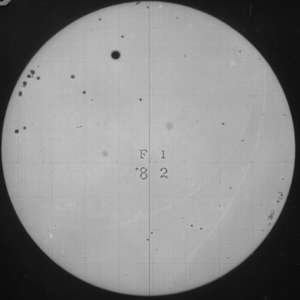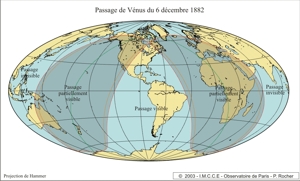
The passage of 1882 will be also the occasion of many voyages. The passage was visible from South America.
The French organized ten missions: a mission to the island of Haiti (Callandreau), one to Mexico (Bouquet of Grye), one to Martinique (Tisserand, Bigourdan, Puiseux), one to Florida (colonel Perrier), to Santa-Cruz in Patagonia (commander Fleuriais), one to Chile (lieutenant of Bernardières), one to Chubut (Hatt), one to Rio-Negro (Perrotin, the director of the observatory of Nice), one to Cape Horn (lieutenant Courcelle-Seneuil) and finally one to Bragado (lieutenant Perrin).
The naval observatory of Washington D.C. sent eight missions throughout the world to observe the passage.

These voyages, again, were not limited to the study of the Venus passage, thus in the Sandwich islands, in 1882, the German settled in Royal Bay within the framework of the first international geophysical year. A similar station was installed by the French in the Orange bay close to Cape Horn. The same day, these two stations recorded strange oscillations of the tide. They knew later than it was a shock wave caused by the explosion of the Krakatoa volcano in Indonesia!

|
| Visibility of the passage of 1882, projection of Hammer |
The reduction of the observations of these last two passages made it possible to Newcomb to calculate a value of the solar parallax with a precision of the order of the hundredth of second of degree. Other measurements of the parallax were used to determine the solar parallax: the measurements of the parallax of Mars in the vicinity of its oppositions were continued. The measurements of the parallaxes of the asteroids at the time of their passages close to the Earth were also conducted. But it will be necessary to await measurements of distance by methods radar to obtain a very good value of the solar parallax and to confirm the good value obtained by Newcomb starting from the Venus passages.
The following table gives a summary of the various determinations of the parallax of the Sun since the middle of the XVIIIth century.
|
Method / author
|
Parallax |
|---|---|
| Passages of 1761 and 1769 | 8,43" and 8,80" |
| Passages of 1761 and 1769, Encke (1824) | 8,5776" |
| Passages of 1761 and 1769, (1835) | 8,571 +/- 0,037" |
| Parallax of Mars, Hall (1862) | 8,841" |
| Parallax of the asteroid Flora, Galle (1875) | 8,873" |
| Parallax of Mars, Gill (1881) | 8,78" |
| Passages of 1874 and 1882, Newcomb (1890) | 8,79" |
| Parallax of the asteroid Eros, Hinks (1900) | 8,806" |
| Parallax of the asteroid Eros, (1941) | 8,790" |
| Radar measurement, NASA (1990) | 8,79415" |